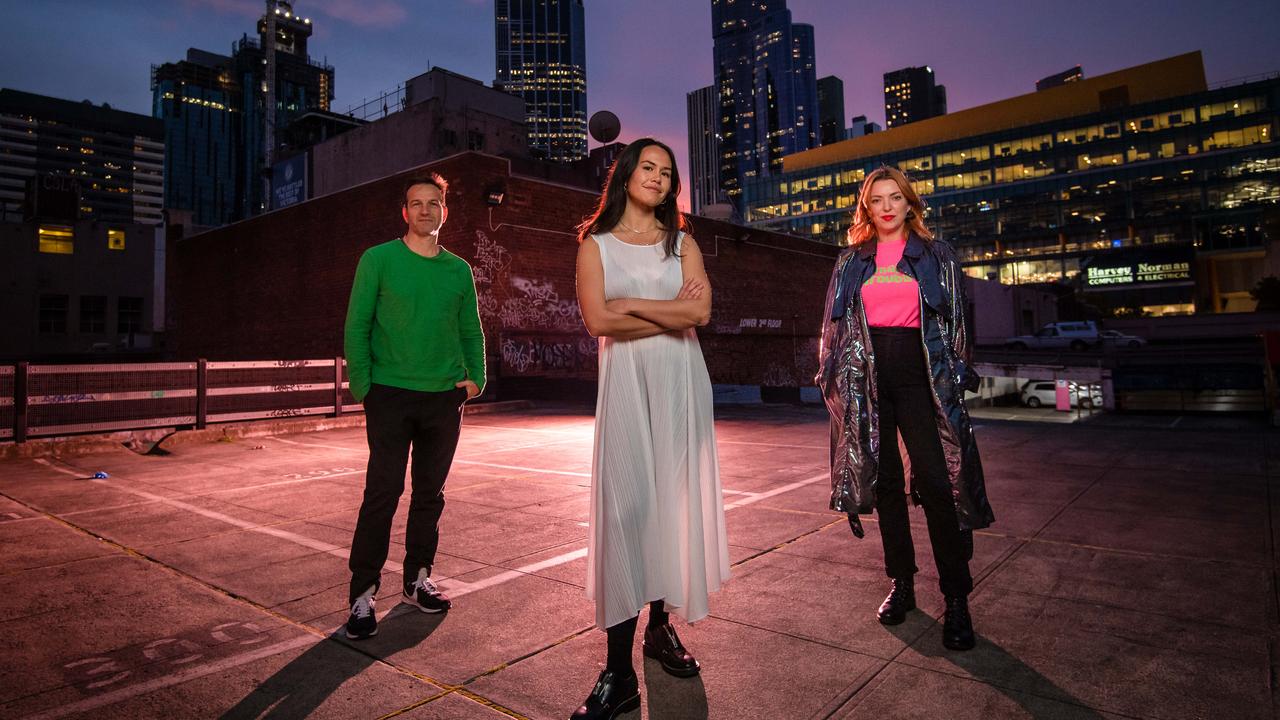China’s terracotta warriors and Cai Guo-Ciang join for NGV Winter Masterpieces
China’s army of ancient terracotta warriors is on the march to NGV, bringing one of the greatest historical finds of the 20th century to Melbourne. But it was pure luck that they were ever found at all.
Arts
Don't miss out on the headlines from Arts. Followed categories will be added to My News.
What a difference a couple of metres can make.
If a Chinese farmer had dug for water just a few steps further east, one of the greatest archaeological finds of the 20th century might still remain hidden underground.
In March 1974, a group of peasant farmers, including Yang Zhifa and his brothers, put spade to earth to find water for their drought-parched persimmon and pomegranate orchard in the Shaanxi province.
HOW GUNPOWDER WILL TRANSFORM ANCIENT WARRIORS
TERRACOTTA WARRIORS, CAI GUO-QIANG ON MARCH TO NGV
ENORMOUS NEW TERRACOTTA ARMY FOUND AT EMPEROR’S TOMB
Instead of water, they stumbled upon the first fragments of what is now widely regarded as the eighth wonder of the world — a staggering life-size terracotta army crafted and buried more than 2300 years earlier to protect China’s first emperor in the afterlife.
Those pieces led to the unearthing of the most significant archaeological site in China, one that rivals the great discoveries in Egypt, Greece and Rome.

But what makes this find all the more astonishing is that there were no historical records, no knowledge at all of this buried army found 1.5km east of the site of Emperor Qin Shi Huang’s tomb mound at Mount Li, Xi’An.
One of China’s most important historical sites was hidden beneath land left to peasants to farm. Some 2000 individual warriors have been excavated and painstakingly reconstructed since.
The total army, estimated at between 6000 and 8000, has been found throughout three burial pits across the 45sq km mausoleum site.
First opened to the public in 1979, the site attracts between 20,000 and 30,000 people each day, marvelling at this astonishing life-size army of ancient warriors.
The site of that fortuitous well is marked on the leading edge of the main burial pit — there are three pits on site — and highlights how lucky Chinese historians are to have this preserved insight into the life and times of China’s first emperor and the Qin dynasty.
A few metres in another direction and this ghost army of warriors, horses and chariots created to defend the emperor in the afterlife that was never meant to be seen by the living, might remain unseen.
In an enormous hangar space more than 230m long and 60m wide, columns of warriors are presented in battle formation facing east. It provides unparalleled insight into the grandeur of the Qin emperor, as well as the battles he victoriously ruled over between the seven warring states that culminated in the unification of China into the nation it is today.
Not simply a megalomaniacal warmonger, Qin Shi Huang standardised language, currency, weights and measures across China — the writing system still in use today.
The warriors, with an incredible diversity of facial expressions and costumes, represent each of China’s seven states.
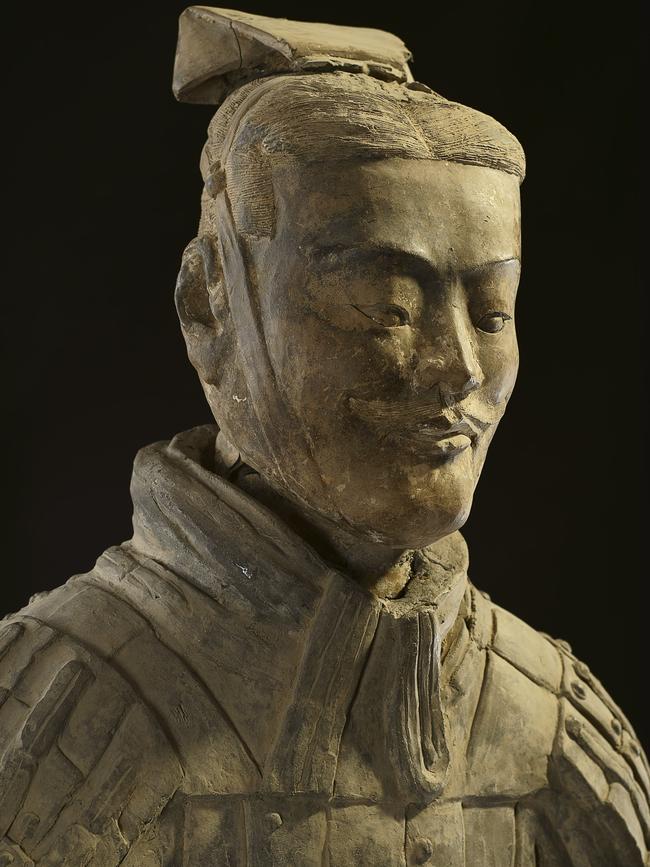
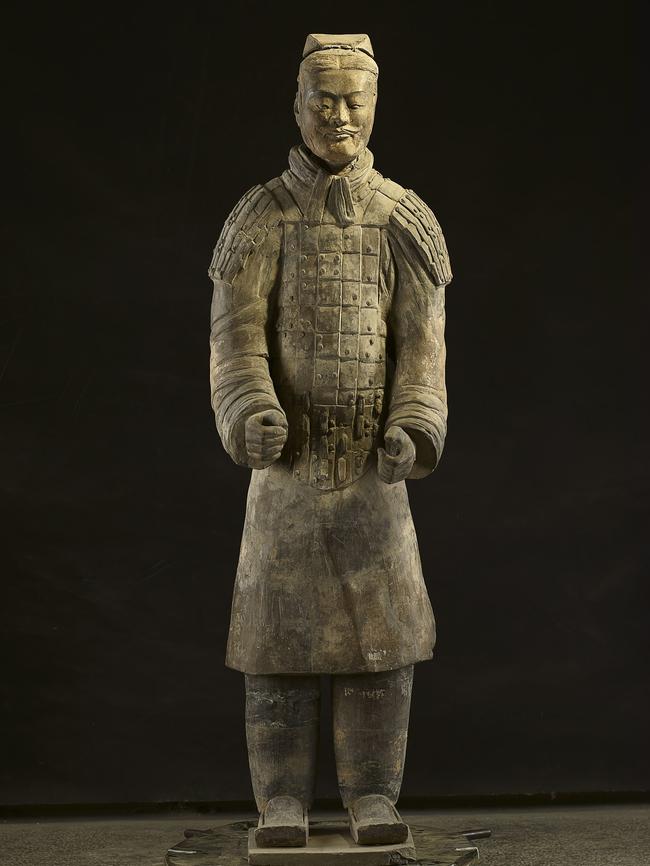
The numbers are astonishing. More than 700,000 artisans and workers — many criminals conscripted into labour — are thought to have worked on constructing the army and tomb complex over about 40 years.
Emperor Qin Shi Huang is believed to have ordered work on the mausoleum even before his coronation at 13, and was said to be obsessed with his legacy — in this world and the next.
Each warrior is almost 2m tall, around 180kg and has unique characteristics, including facial hair and hairstyles. Some have topknots, others goatees; some wear caps and tunics, others armour. They have different builds, expressions and postures.
Each warrior takes between two months and a year to recreate from excavated pieces, with at least 50 archaeologists still working the three main sites.
Other items uncovered include 40,000 pieces of weaponry, mainly arrowheads, and it’s thought 150 cavalry horses and 140 battle chariots drawn by 520 chariot horses exist across the three pits under excavation.
Ma Shengtao, from the Terracotta Warriors Museum in Xi’An, says the work is slow and laborious.
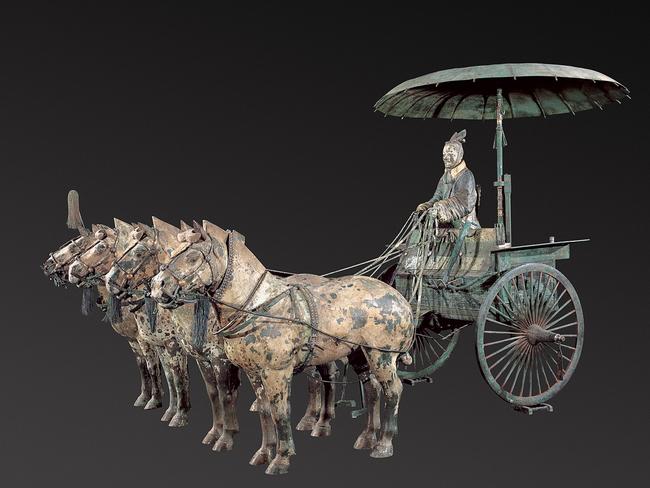
“The goal is to replace the warriors where they were found, once they have been reconstructed,” he says. “Eventually, they all will be made whole, but this will take a very long time. For now, we have worked for (the past) 10 years and we have made 200, so it’s hard to say (when the work will be finished).”
Six years after the discovery of the warriors, the potential splendour of the emperor’s mausoleum was confirmed with the discovery of two bronze chariots. Reconstructed from thousands of pieces and decorated with gold and silver, the chariots — one is an open battlefield chariot, the other a covered chariot used to make imperial tours of the empire — are the only two discovered so far and, as such, do not leave China.
But exact replicas will travel to Melbourne for Terracotta Warriors: Guardians of Immortality, part of this year’s National Gallery of Victoria’s winter masterpieces.
They will be displayed alongside other treasures from the Qin dynasty. These include eight original warriors, two full-sized horses and objects lent by museums and archaeological sites from across Shaanxi province, such as priceless gold, jade and bronze artefacts dating from the Zhou dynasty (1050-256 BCE) to the Han dynasty (206 BCE-220 CE).
It’s not the first time the terracotta army has been exhibited at the NGV. In 1982, the gallery was the first place outside China that the warriors were seen.
NGV senior curator of Asian art Wayne Crothers says the time is right for them to return, and in a more comprehensive manner.
“They are such an important historical, archaeological, cultural, enlightening discovery that almost 40 years after their initial exhibition, they are something that inspires people’s imagination and curiosity about China, about Chinese history and Chinese history’s relevance in a contemporary context,” he says.
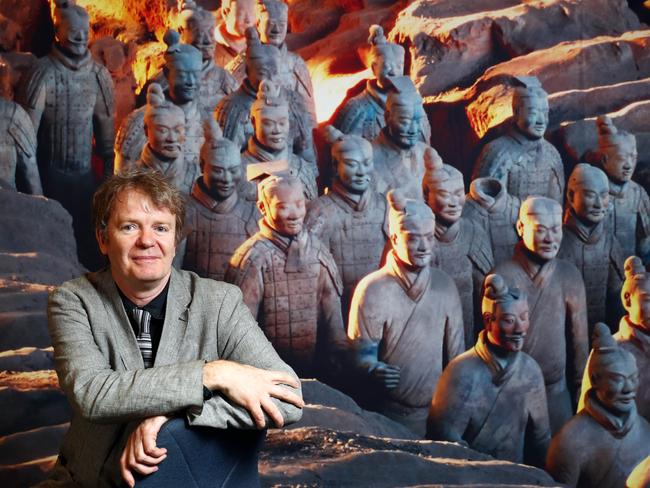
With more than 170 objects, this exhibition dwarfs the 19 pieces of the initial showing.
“In the exhibition there are a lot of interesting design elements,” Crothers says.
“We’re an art gallery, rather than a museum. We display works, we focus on them from an artistic perspective.
“People understand the NGV allows people a sensory or immersive experience when they visit an exhibition. We like to draw out dialogues between contemporary and history’s activities.”
Given the interest in this vast army, the emperor’s tomb is a source of international speculation about the treasures it surely contains, but Shen Maosheng, from the Terracotta Museum, says the mausoleum, which is watertight and airtight, will remain untouched.
“We won’t dig up the emperor’s mausoleum. Never. It’s the most important treasure,” he says. “The policy here in China, the main thing is to protect and maintain.
“Of course we’re curious about it, but the duty is to protect it. That’s much more important than curiosity.”
He says the main focus of the museum is to continue exploring pits one to three, as well as confirming the scale of the mausoleum site.
The kilns used to create the terracotta army are also yet to be found and are an area of interest to the museum’s archaeologists.
“We have found some kilns for making construction pieces, the bricks for the walls, but haven’t found those that were for making the warriors. We predict they are nearby but we haven’t found any yet,” Shen says.
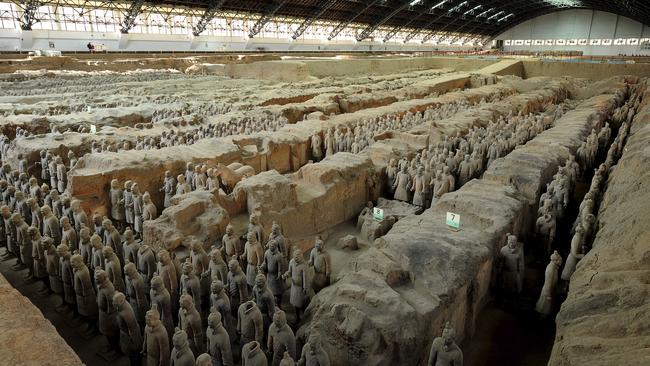
With such a vast number of workers, how did no record of the tomb complex or the army make its way into any documentation or folklore?
Human remains, numbering in the tens of thousands, have been discovered in the area. It appears the artists who created the terracotta army were killed and buried with their work to keep their silence. They literally took the secret of the warriors to the grave.
Crothers says this artisanship of the warriors makes them such unique historical artefacts. Made from moulds that produced similar castings, they were then crafted into an incredible array of facial expressions and costumes, with the army comprising individual identities.
“They obviously had artistically gifted craftsmen who knew how to sculpt a face, how to build different personalities,” he says.
“These were the first life-size human representations in China that had been produced until that time and much, much later through the following dynasties. The exhibition is bringing in design, history, craftsmanship, artisanship as well as contemporary interpretation and philosophies.”

A juxtaposition of ancient culture and the contemporary makes NGV’s presentation of the warriors unique. In a world first, alongside the treasures from the past will be a display of new works by Chinese contemporary artist Cai Guo-Qiang.
The Chinese-born, New York-based artist uses gunpowder and fireworks to create performative pieces that harness spectacle into the art-making process.
THE MODERN MASTERY OF CAI GUO-QIANG
Running in parallel with Terracotta Warriors: Guardians of Immortality at NGV International from this month, Cai Guo-Qiang: The Transient Landscape will feature the artist’s new works, including a flock of 10,000 porcelain starlings, a porcelain sculpture of peonies and one of his signature gunpowder drawings.
Spiralling over the gallery roof, the birds will create a three-dimensional impression of a calligraphic drawing of Mount Li, the siteof Qin Shi Huang’s tomb.
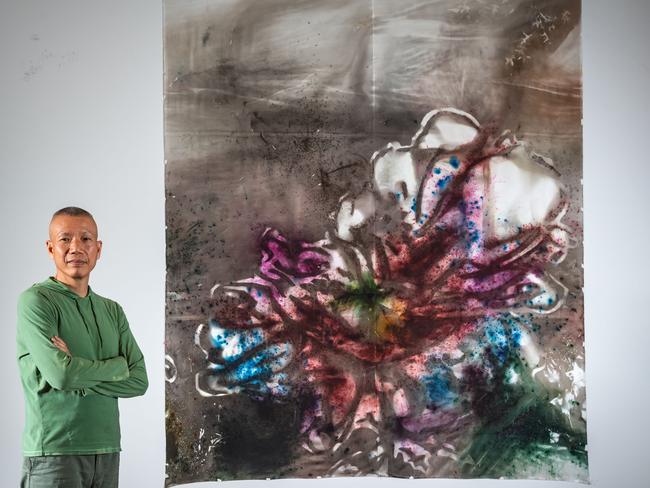
Crothers says of all the contemporary Chinese artists, Cia’s approach and his work was the most appropriate to feature as the complementing exhibition.
“Cia is someone the NGV’s been wanting to do a major exhibition with for many years, we’ve been wanting to do a major historical show with the warriors for many years, and the two just really made so much sense to us to bring together,” he says.
The artist first visited the warriors as a young man with his then girlfriend, now wife.
“I was very touched by the presentation of the underground army,” he says. “Not because the individual sculptures are amazing but because the entire presentation of the sheer number of soldiers is a representation of installation art.
“Of course, when I’m working with them now, each sculpture has an individuality, in expression, hair and facial hair (they) are all different. Making a large number of terracotta warriors and burying them underground is a very conceptual act. It’s not conceptual art, but a more conceptual act.”
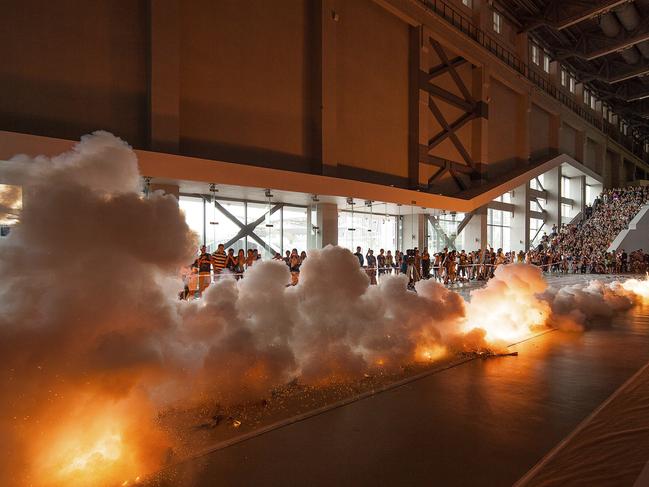
He hopes Australian audiences will gain an understanding of the vastness of Chinese history through the interplay of his works with the warriors.
“The most interesting element for me is that they are presenting contemporary art and Asian artefacts together in a series of galleries,” he says.
“That’s how I came up with the idea of making 10,000 birds.
“Even though we only have a few terracotta warriors in the exhibition space, we have a huge number of birds in the sky, representing the lingering spirit of the underground army.”
Cai can’t predict how an Australian audience will relate to contemporary and ancient China being shown together in the same space, but his wish is to convey two rivers of time crossing the gallery — sometimes the works will have nothing to do with the other, other times they will form a dialogue, a relationship.
“I hope it’s not just about the glory of the ancient Chinese culture, instead it should raise several questions at different places,” he says.
“For example showing the life and death of the peony flowers, from blossoming to withering and death.
“Or the 10,000 birds could be a symbol of the lingering spirit of the empire. It’s not just about showing the greatness of the Asian artefacts. This NGV project allows me to look back at my Chinese predecessors.”
And what of the farmers who found the army? Only one is alive today. In his 80s, he used to go into the museum to sign books for souvenirs, but tired of tourists questioning whether he was an actor planted for their benefit.
Now, he signs books at his home nearby that are delivered to the gift shop.
TERRACOTTA WARRIORS: GUARDIANS OF IMMORTALITY AND CAI GUO-CIANG: THE TRANSIENT LANDSCAPE, NGV INTERNATIONAL, MAY 24-OCTOBER 13.
DAN STOCK TRAVELLED TO CHINA COURTESY OF NGV


